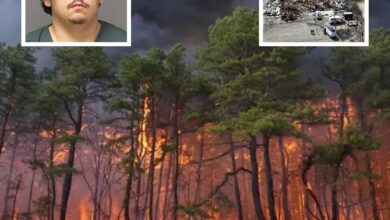Tree killing beetle may cause more wildfires, Long Island officials warn

They’re not out of the woods yet.
Long Island’s vulnerable pine barrens, recently ravaged by wildfires last March, are facing another threat in the form of an invasive species that could spell another incendiary disaster, officials warn.
The southern pine beetle, which migrated to the eastern end of Suffolk County a decade ago, is ravaging the local ecosystem by drying out trees and making them susceptible to fire weather.
“This is a serious, serious problem,” Suffolk County Executive Ed Romaine told The Post.
“They’ve eaten through hundreds, if not thousands of acres of pine trees…these trees die, they look terrible, they’re not coming back to life, and then they provide fodder for fires,” he added.
The beetle penetrates the tree bark, causing its sap to stop flowing. From there, green pine needles turn orange, and the tree becomes dead wood.
Romaine said a dozen trees a day are falling victim to the insect, explaining that the end of the South Fork has also taken a ferocious beating from the tree killer.
“You drive out to Montauk, you look at Amagansett, it’s like ‘oh my God, what happened here?’” Romaine said of the once scenic Montauk Highway leading toward Hither Hills State Park.
“You also see it in Manorville and Calverton, Yaphank, and Upton, around Brookhaven National Lab. It’s like a little army that’s moving very slowly but deliberately to eat their way through.”
Suffolk’s Commissioner of Fire Rescue and Emergency Services, Rudy Sunderman, explained that, along with fire risk — it has caused brush fires in the past — there are other hazards associated with the troublesome critter.
“The pine beetle issue does cause falling trees, leaning trees,” he said.
“We’ve been working on that, clearing trails of dangerous trees…So we’re currently working on methods to mitigate these problems.”
The telltale sign of its presence is small, roundish holes in a tree’s bark, according to Sunderman.
“It’s kind of weird,” he said. “You see these pine trees, and then the bark is peeling.”
Breaking up the beetles
The best way to eradicate the beetle is cold weather — but “we haven’t had enough cold weather,” Romaine said.
Now, he’s hoping that the state will put money toward natural insecticides that may be able to halt the bug battalions.
The county executive is especially concerned about the beetles this season, following the situation in California last January.
“Far more destructive than fire is the pine beetle itself,” he said. “Because it’s killing so many trees every single day, and they’re helping to deforest our pine barrens. It’s very concerning.”
To raise awareness, the county is hosting a symposium on the pine beetle and wildfire prevention for residents on Weds. April 23 at Suffolk Community College’s Riverhead campus.
Romaine said waiting ten years to do something has had enough consequences, and the time to act is now.
“We just haven’t addressed this…I want to call attention to this issue,” said Romaine. “Otherwise, we’re going to see our pine barrens denuded, and that’s going to be a problem.”




